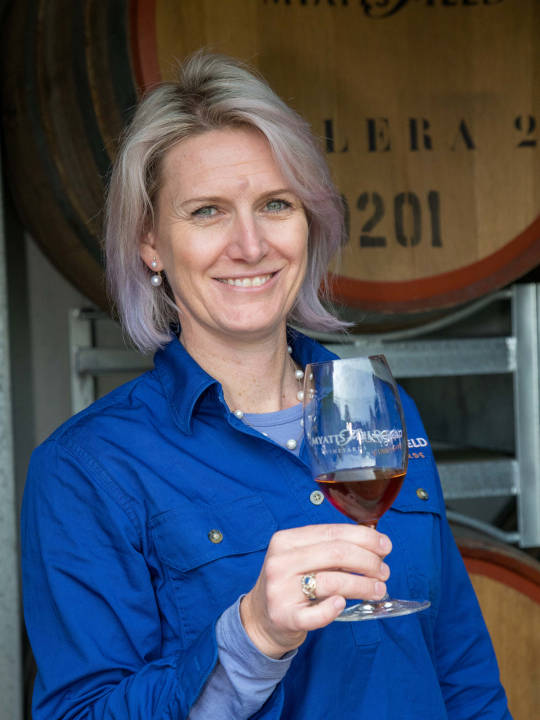RACHAEL DAVENPORT
WINEMAKER AT MYATTSFIELD
“Winemaking is a beautiful blend of science and art”
When did you realise you wanted to become a winemaker?
I was fifteen and completing work experience in a hospital when I decided the health system wasn’t for me. During that period, I was helping my father plant and operate a vineyard in the Grampians. This experience opened my eyes to the world of Viticulture and Oenology.
Please tell us about your career so far, including your education, work experience etc.
After high school, I went to Adelaide University to study Oenology. After graduating I used my qualifications to travel and spent 5 years travelling between the southern and northern hemispheres, making wine in different regions. As a result, I have worked in New Zealand (Central Otago), Italy (Sud Triol), USA (Sonoma), France (Languedoc-Roussillon, Cognac), Portugal (Alentejo) as well as different areas in Australia (Hunter Valley, Grampians, McLaren Vale, Robinvale, Swan Valley and Perth Hills).
What do you love most about being a winemaker?
Winemaking is a beautiful blend of science and art. I love that every day is different and every year is different. Each vintage produces its own challenges and as much as you try you might never make the same wine. Each year there is an opportunity to make better wine. Making wine is an art and a historical marker.
What is your favourite wine, and what food do you typically pair it with?
I am a sucker for bubbles and potatoes, thus champagne with potato chips would be an old favourite.
Is there a specific process you follow when developing a new wine?
I develop a style plan, which accurately describes the end product. From this I work backwards, ensuring each step of the winemaking process is commensurate with the outcomes I have outlined. On occasion mother nature will step in and complicate matters, changing fruit composition with seasonal variations and I must adapt to make sure the best result is achieved. While this can be frustrating, the dynamic nature of the process is exciting and memorable. I am also fortunate enough to work with two other talented winemakers. On occasions, we will set a challenge of using one parcel of fruit and dividing it between the three of us to impact our own winemaking ideas. Once the wine is bottled, we involve customers and have them vote on which style they enjoy the most. This allows us to experiment and fast-track ideas from one vintage to another.
Is there any vintage you’re particularly proud of creating? Why?
2017 was the most challenging vintage of my career. The season was wet, and the disease pressures were the worst I have ever seen. I was then happy we were able to make something out of the vintage and proud when the wines turned out to be better than alright. After many years of vintaging and travelling, 2004 was the first time I was responsible for the whole process from the vine to the bottle. Twenty years on, I have recently had a bottle of Cabernet Sauvignon from 2004 and with great delight. The wine was delicious.
How does the local climate/soil affect the wine you make?
We have some of the oldest soils in the world here in Western Australia. The prized ironstone gravels over clay ensure the vines work hard and produce moderate yields with great flavour concentration. The undulating landscape of the Perth Hills region also means the microclimate (climate of site) is variable. Choosing the right variety for the site is key to getting the best results. We are proud to have been planting what were considered alternate varietals such as Mourvedre, Durif, Touriga and Tempranillo at the turn of the last century as a direct result of climatic comparisons with the warmer regions of Spain and Portugal.
Which of your own varieties do you typically indulge in?
I love sparkling winemaking, but I work in a warm region. Vermentino is my answer to warm climate sparkling winemaking. It copes well in hot and dry conditions, maintaining good acid levels. If picked early, it produces a fresh zippy, low alcohol wine suitable for sparkling. It also produces a delicious table wine when left to ripen a touch more.
Where do you see yourself in five years? How do you think your winemaking will evolve during this time?
Like much of the industry, we have toned down alcohol levels and sought more elegance and refinement in our winemaking. I enjoy working with ceramics and the new evolution of yeast nutrients now available on the market. In the vineyard we are investing in new plantings of Montepulciano, a variety we see as well suited to our region. I feel the hardest years are behind us in terms of establishment and the next 10 years offer more time and resources to focus on refining our winemaking.

